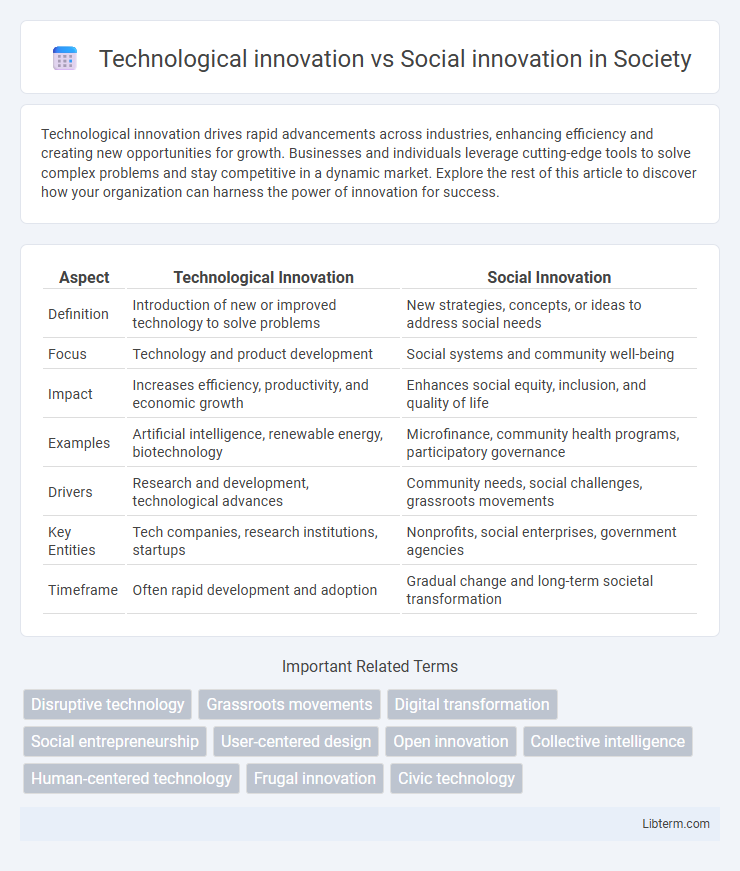Technological innovation drives rapid advancements across industries, enhancing efficiency and creating new opportunities for growth. Businesses and individuals leverage cutting-edge tools to solve complex problems and stay competitive in a dynamic market. Explore the rest of this article to discover how your organization can harness the power of innovation for success.
Table of Comparison
| Aspect | Technological Innovation | Social Innovation |
|---|---|---|
| Definition | Introduction of new or improved technology to solve problems | New strategies, concepts, or ideas to address social needs |
| Focus | Technology and product development | Social systems and community well-being |
| Impact | Increases efficiency, productivity, and economic growth | Enhances social equity, inclusion, and quality of life |
| Examples | Artificial intelligence, renewable energy, biotechnology | Microfinance, community health programs, participatory governance |
| Drivers | Research and development, technological advances | Community needs, social challenges, grassroots movements |
| Key Entities | Tech companies, research institutions, startups | Nonprofits, social enterprises, government agencies |
| Timeframe | Often rapid development and adoption | Gradual change and long-term societal transformation |
Introduction to Technological and Social Innovation
Technological innovation involves developing new tools, systems, or methods that improve productivity and efficiency, often driven by advancements in science and engineering. Social innovation focuses on creating novel strategies, concepts, or organizations that address social needs and improve community well-being, emphasizing collaboration and inclusivity. Both forms of innovation play crucial roles in fostering sustainable development and addressing complex global challenges.
Defining Technological Innovation
Technological innovation refers to the development and application of new technologies, products, or processes that improve efficiency, functionality, or quality. It often involves breakthroughs in fields such as information technology, engineering, and biotechnology, leading to tangible advancements like automation, artificial intelligence, or renewable energy solutions. This type of innovation primarily focuses on creating novel tools and systems that transform industries and drive economic growth.
Understanding Social Innovation
Social innovation involves developing new strategies, concepts, and ideas that address societal challenges by improving human well-being and social relationships. Unlike technological innovation, which primarily focuses on creating or enhancing products and services through technological advancements, social innovation emphasizes community engagement, inclusive participation, and systemic change. Successful social innovations often result in sustainable social impact by fostering collaboration among diverse stakeholders and addressing root causes of social issues.
Key Differences Between Technological and Social Innovation
Technological innovation primarily focuses on developing new tools, products, or processes that improve efficiency and functionality, often driven by advancements in science and engineering. Social innovation targets novel strategies, concepts, or organizations aimed at addressing social needs and improving community well-being, emphasizing behavioral and systemic change over technical improvements. Key differences include the nature of impact--technological innovations transform industries and markets, while social innovations reshape societal norms and improve social equity.
The Synergy Between Technology and Social Change
Technological innovation and social innovation intersect to create powerful synergies that drive societal progress by combining cutting-edge tools with transformative social practices. Advances in artificial intelligence, blockchain, and renewable energy technologies amplify the impact of social initiatives addressing healthcare, education, and environmental sustainability. Harnessing technology to foster inclusivity and equity accelerates systemic change, creating resilient communities and adaptive governance models.
Real-World Examples of Technological Innovation
Technological innovation drives advancements in fields like artificial intelligence, renewable energy, and biotechnology, exemplified by Tesla's development of electric vehicles and SpaceX's reusable rockets. These innovations transform industries by enhancing efficiency, reducing environmental impact, and expanding human capabilities. Real-world technological breakthroughs such as CRISPR gene editing and 5G networks highlight the tangible benefits and societal shifts driven by cutting-edge technology.
Impactful Case Studies in Social Innovation
Social innovation case studies such as the Grameen Bank's microcredit model demonstrate profound impacts on poverty alleviation and financial inclusion in developing countries, showcasing how novel social approaches address systemic issues. Another example is the rise of community-driven renewable energy projects in Denmark, which empower local populations and promote sustainability without relying solely on advanced technology. These instances reveal that social innovation often yields transformative community benefits by fostering collaboration, equity, and scalable solutions that technological innovation alone may not achieve.
Benefits and Challenges of Technological Innovation
Technological innovation drives economic growth by enhancing productivity and creating new market opportunities through advancements such as artificial intelligence and automation. However, challenges include high implementation costs, potential job displacement, and cybersecurity risks that require robust regulatory frameworks. Balancing innovation benefits with ethical considerations ensures sustainable development and social acceptance.
Benefits and Challenges of Social Innovation
Social innovation drives inclusive solutions by addressing complex societal issues such as poverty, education, and healthcare, often resulting in enhanced community resilience and social cohesion. Its benefits include fostering collaboration across diverse stakeholders and promoting sustainable development, but challenges arise from scaling impact, securing continuous funding, and measuring social value effectively. Unlike technological innovation, social innovation heavily relies on changing social behaviors and cultural norms, which can slow adoption and require long-term commitment.
Future Trends: Blending Technological and Social Innovation
Future trends highlight the convergence of technological innovation and social innovation as key drivers of sustainable progress. Advanced technologies like artificial intelligence and blockchain are increasingly integrated with social frameworks to address complex societal challenges such as healthcare, education, and climate change. This blend promotes inclusive solutions that enhance community resilience and foster equitable opportunities globally.
Technological innovation Infographic

 libterm.com
libterm.com